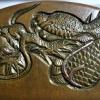-
Posts
6,963 -
Joined
-
Last visited
-
Days Won
44
Content Type
Profiles
Forums
Events
Store
Downloads
Gallery
Everything posted by Alex A
-

katana inquiry with cutting test.
Alex A replied to dimitri's topic in General Nihonto Related Discussion
Was just thinking of the possibility a later generation but you have to take into account the date on the cutting test write-up. Not saying there are no winners when it comes to auctions but im not the optimistic type and don't have money to gamble Maybe an expert that has it in hand may be more confident,. Could never bid on what's available and without taking a real deep trip through the books. not for me. -

katana inquiry with cutting test.
Alex A replied to dimitri's topic in General Nihonto Related Discussion
Expensive, see Katana by well known smiths 10k upwards https://www.aoijapan.com/katana-bizen-suke-fujiwara-munetsugunbthk-tokubetsu-hozon-token/ Sometimes you see wakizashi for half that. Also, on rare occasion you come across a good private deal. Always a compromise though, the sword is mediocre or it was tested by a lesser known sword tester etc etc. Most folks just say buy the sword, not the inscription. Depends what you like. -
Cheers Grev. He really does do his research and sits on the fence with stuff he is not sure about. Not just limited to edged weapons, he has also done some very informative vids on some firearms and their use in battles. The last bunch he talks about, i didn't know they were mainly used for law enforcement. Think i saw something similar at the Royal Armouries, from memory.
-

katana inquiry with cutting test.
Alex A replied to dimitri's topic in General Nihonto Related Discussion
Hi First off, Id be asking myself why a Hizen Kuni Tadayoshi (top notch smith and always a target for gimei) with a cutting test is for sale on an auction site without mention of Shinsa papers ? -
I like this guys vids because he really knows his antique blades (of all types) and explains how they were used. Good vid, especially for folk not too clued up on the use of such weapons.
-
If 4 still available let me know. Cheers
-
Lets not forget that carrying two swords (as in daisho-long /short sword) did not become the trend up until around the end of the Muromachi period or thereabouts. And on that note think I've said everything i want to say on the subject. Horses for courses as they say.
-
Going round in circles here We all know what a true Daisho is. But the FACT is, not all Samurai carried TRUE daisho. That should be the end.
-
Hi John, im also confused, what history is being created and what's selfish ?
-
Its about what you can live with Colin. The way i look at it, if the Many Samurai were able to live with Daisho that did not match then its good enough for me. If folk want to create their own Daisho then later want to sell, then they need to understand lots of buyers wont share their thoughts as to it being a "daisho" Personally, for display purpose. If i wanted a Daisho and someone had cobbled one together well, i wouldn't get to hung up about it and may be tempted. You see them occasionally at Aoi and other stores.
-
Ask yourself what you would rather own ?, may be interesting as we all look at things differently. Take value out of the equation An Edo katana and wakizashi signed by the same smith and made at the same time with matching fittings that were all put together in recent years,. or An Antique Katana and a Wakizashi by different smiths in similar koshirae that have provenance to have been owned by a Samurai in 1850 and showing appropriate wear.
-
Forgot to reply earlier. Always reassuring to know even experts give differing opinions, not just the folks here. Folks often say "send it off to shinsa, to the real experts" Even they don't see eye to eye on some swords. Another topic though but thought it was another interesting interlude.
-
Another case of the biggest problem in Nihonto, folks constantly insisting everything neatly fits into suitable boxes/brackets, as that's usually the case in books. Whether swords, tsuba, whatever.
-
All of those listed above are Katana/wakizashi, no tanto, that was 1702. Not all had a wak. (reading again) See lots of images at the end of the Edo, Katana/tanto. First photo taken in Japan was 1861 according to the internet. Just wondering if trends had changed by then and for general mooching about many just chose the tanto?, dunno. Read of daisho with 2 waks, A few reasons for non-matching sword daisho, off top of head. They were expensive. One had a Katana handed down, its precious and 200 years old, how you going to get the smith to make a wak? You had a matching daisho but the katana shattered like glass in a duel, you don't want another by that smith You don't like the local swords so just grab what you can when you get the chance. Your master gave you a katana but no wak You stole a better katana on the battlefield Someone stole your katana so you had to buy another. You just don't care whether they match or not. You seen a better katana in a dealers that was a bargain. You cut your finger on the wak, you think its cursed and so on................. If i was to meet some old dude in Japan that had a daisho and he was saying they were his great great grandfathers daisho but went on to say they are by diffrent smiths at different times, im hardly likely to go "WHOA, what you talking about?, that's not a TRUE daisho!!!!!!!!!!" In an ideal world they would be matching and every Samurai would be walking around with a smile knowing they were matching. But its not an ideal world and definitely wasn't back then.
-
Think about all the swords handed down and the reasons why some would not have wanted or been able to attain a "true" daisho.
-
For those that have not looked Japanese SWORD - Swords of the 47 Ronin (japaneseswordindex.com) Think 5 out of the 33 mentioned had matching mei.
-
Looks slender, maybe its one of those tourist pieces from the end of the Edo period.
-
Cheers Chris, the real ones above have that aged look, real age. Also, agree about educating the folk that want to learn. Its good of you to do so and hopefully may well prevent someone being taken for a ride.. Ps, the one that Luc put on here, newbie thoughts, it just looks too much.
-
Interesting Chris, im now sat here wondering if the forgers iron out the errors such as the seam at the front, will they become so difficult to detect that even experts have trouble working them out ? You mention that you have seen a few on Yahoo. Maybe one or two go under the radar but then seeing more and more leads to red alert warning to educated buyers. Its like Ebay where you see so many of those modern cast tsuba from China floating about. Was on another forum a while ago asking about fakes and one guy stated "We try and not make them any more knowledgeable than we have too". Some folks really take it serious, information to fraudsters.. I guess at the end of the day its the naive that will take the brunt, as always.
-
When any (potentially) big name blade in polish arises, one must ask theirself is there a chance it has already been to Shinsa.
-

sword blades with special signatures and dates
Alex A replied to Volker62's topic in General Nihonto Related Discussion
Great idea for a thread, these inscriptions make a sword a lot more desirable!. -
Id go late Edo Colin.
-
From another's perspective. Your complaining about amateurs working on armour, they are going to do it whether you like it or not. If you care so much about the armours they are ruining then would it not make more sense to give advice and help prevent more armour being ruined? Obviously see your point but just a thought.





